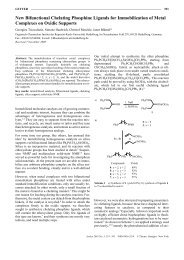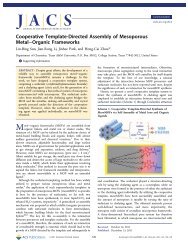Elucidating Changes in Interfacial Water Structure upon Protein ...
Elucidating Changes in Interfacial Water Structure upon Protein ...
Elucidating Changes in Interfacial Water Structure upon Protein ...
Create successful ePaper yourself
Turn your PDF publications into a flip-book with our unique Google optimized e-Paper software.
[26] V. A. Daragan, K. H. Mayo, J. Phys. Chem. 1996, 100, 8378.<br />
[27] V. A. Daragan, K. H. Mayo, J. Phys. Chem. B 1999, 103, 6829.<br />
[28] N. Tjandra, S. E. Feller, R. W. Pastor, A. Bax, J. Am. Chem. Soc. 1995, 117,<br />
12 562.<br />
[29] B. Brutscher, N. R. Skrynnikov, T. Bremi, R. Brüschweiler, R. R. Ernst, J. Magn.<br />
Reson. 1998, 130, 346.<br />
[30] M. W. F. Fischer, L. Zeng, Y. Pang, W. Hu, A. Majumdar, E. R. P. Zuiderweg, J.<br />
Am. Chem. Soc. 1997, 119, 12 629.<br />
[31] J.-C. Hus, D. Marion, M. Blackledge, J. Am. Chem. Soc. 1999, 121, 2311.<br />
[32] C. Richter, C. Gries<strong>in</strong>ger, I. Felli, P. T. Cole, G. Varani, H. Schwalbe, J. Biomol.<br />
NMR 1999, 15, 241.<br />
[33] G. Cornilescu, J. L. Marquardt, M. Ottiger, A. Bax, J. Am. Chem. Soc. 1998,<br />
120, 6836.<br />
[34] J. A. Braatz, M. D. Paulsen, R. L. Ornste<strong>in</strong>, J. Biomol. Struct. Dyn. 1992, 9,<br />
935.<br />
[35] P. J. Hagerman, B. H. Zimm, Biopolymers 1981, 27, 1481.<br />
[36] S. Vijay-Kumar, C. E. Bugg, W. J. Cook, J. Mol. Biol. 1987, 194, 531.<br />
[37] R. Koradi, M. Billeter, K. Wüthrich, J. Mol. Graphics 1996, 14, 51.<br />
[38] G. Cornilescu, J.-S. Hu, A. Bax, J. Am. Chem. Soc. 1999, 121, 2949.<br />
[39] B. Reif, A. Diener, M. Hennig, M. Maurer, C. Gries<strong>in</strong>ger, J. Magn. Reson.<br />
2000, 143, 45.<br />
[40] R. Sprangers, M. J. Bottomley, J. P. L<strong>in</strong>ge, J. Schultz, M. Nilges, M. Sattler, J.<br />
Biomol. NMR 2000, 16, 47.<br />
[41] K. L. Lee, M. Rance, W. J. Chaz<strong>in</strong>, A. G. Palmer, J. Biomol. NMR 1997, 9, 287.<br />
Received: February 5, 2001 [Z 186]<br />
<strong>Elucidat<strong>in</strong>g</strong> <strong>Changes</strong> <strong>in</strong> <strong>Interfacial</strong><br />
<strong>Water</strong> <strong>Structure</strong> <strong>upon</strong> Prote<strong>in</strong><br />
Adsorption<br />
Joonyeong Kim and Paul S. Cremer* [a]<br />
KEYWORDS:<br />
BSA adsorption ´ sum-frequency generation ´<br />
surface chemistry ´ water chemistry ´ zeta potential<br />
The adsorption of prote<strong>in</strong>s from solution onto solid surfaces has<br />
ga<strong>in</strong>ed much attention due to its scientific importance [1±3] as well<br />
as its applications <strong>in</strong> biofoul<strong>in</strong>g, [4] food process<strong>in</strong>g, [5] biosensor<br />
development, [6] and the construction of biocompatible materials.<br />
[7] Previous researchers have used a host of diagnostic<br />
methods to study this problem. These <strong>in</strong>clude circular dichroism,<br />
[8] fluorescent microscopy, [9] neutron reflectivity, [10, 11] surface<br />
plasmon resonance spectroscopy, [12] attenuated total <strong>in</strong>ternal<br />
reflection Fourier transform spectroscopy, [13] and the quartz<br />
[a] Prof. P. S. Cremer, J. Kim<br />
Department of Chemistry<br />
Texas A&M University<br />
P.O. Box 30012, College Station, TX 77842-3012 (USA)<br />
Fax: (‡ 1) 979-845-7561<br />
E-mail: cremer@mail.chem.tamu.edu<br />
Support<strong>in</strong>g <strong>in</strong>formation for this article is available on the WWW under<br />
http://www.chemphyschem.com or from the author.<br />
crystal microbalance technique. [14] The results have consistently<br />
shown that prote<strong>in</strong> adsorption is a complex phenomenon<br />
<strong>in</strong>volv<strong>in</strong>g a series of dynamic steps from the <strong>in</strong>itial <strong>in</strong>terfacial<br />
recruitment to the f<strong>in</strong>al structural rearrangements.<br />
Despite these efforts, little is known about the role played by<br />
[15, 16]<br />
<strong>in</strong>terfacial water <strong>in</strong> mediat<strong>in</strong>g the adsorption process<br />
because molecular level <strong>in</strong>formation from both the substrate<br />
surface and prote<strong>in</strong> hydration shells is normally obscured by the<br />
contribution of the bulk aqueous solution. This is unfortunate<br />
because the role of water is probably crucial. Indeed, prote<strong>in</strong><br />
adsorption at the liquid/solid <strong>in</strong>terface could <strong>in</strong>volve the wholesale<br />
realignment of the hydration shells of am<strong>in</strong>o acid residues at<br />
the prote<strong>in</strong>s' surface. [15±17] Furthermore, substrate-associated<br />
water molecules may be heavily disrupted or completely<br />
displaced <strong>upon</strong> the b<strong>in</strong>d<strong>in</strong>g of a soluble prote<strong>in</strong>.<br />
Unlike bulk water, <strong>in</strong>terfacial water structure usually exhibits<br />
spatial orientation with respect to the underly<strong>in</strong>g surface and<br />
thereby lacks <strong>in</strong>version symmetry. This fact enables sumfrequency<br />
generation (SFG), a surface-specific vibrational spectroscopy,<br />
to <strong>in</strong>vestigate these buried aqueous <strong>in</strong>terfaces with<br />
high selectivity. [18±20] Previous nonl<strong>in</strong>ear optical studies of<br />
<strong>in</strong>terfacial water structure at the silica/water <strong>in</strong>terface have<br />
shown that water order<strong>in</strong>g is primarily governed by the surface<br />
[18, 21]<br />
charge density, which is <strong>in</strong> turn regulated by the bulk pH.<br />
In this Communication, we report SFG data on the structure<br />
and rearrangement of <strong>in</strong>terfacial water <strong>upon</strong> bov<strong>in</strong>e serum<br />
album<strong>in</strong> (BSA) adsorption at the silica/water <strong>in</strong>terface as a<br />
function of bulk pH and prote<strong>in</strong> concentration. It is shown that<br />
the water structure reorganizes on a timescale that is concomitant<br />
with the prote<strong>in</strong> adsorption process and that the molecular<br />
order<strong>in</strong>g of water is highly dependent on the prevail<strong>in</strong>g surface<br />
charge density.<br />
The theory and experimental setup of SFG have been<br />
described <strong>in</strong> detail elsewhere. [22, 23] We have chosen to study<br />
[1, 8, 10, 11, 25]<br />
BSA adsorption because both its <strong>in</strong>terfacial behavior<br />
and structural properties <strong>in</strong> solution [24] have been well characterized.<br />
SFG spectra of the silica/water <strong>in</strong>terface <strong>in</strong> the O H stretch<br />
region before and after BSA adsorption at pH 8.0, 5.6, and 3.8 are<br />
shown <strong>in</strong> Figure 1. The spectra conta<strong>in</strong> two major features. The<br />
first peak, located at 3200 cm 1 , is associated with the OH<br />
symmetric stretch of tetrahedrally coord<strong>in</strong>ated water molecules<br />
or ªice-likeº structure. [26±28] The second peak, around 3400 cm 1 ,<br />
is from water molecules with less ordered hydrogen bond<strong>in</strong>g or<br />
ªwater-likeº structure. [26, 29] In Figure 1 a, both the ice-like and<br />
water-like peak <strong>in</strong>tensities from the bare silica/water <strong>in</strong>terface<br />
decreased as the pH was lowered, consistent with previous<br />
studies. [18]<br />
Figure 1b shows SFG spectra from the silica/water <strong>in</strong>terface<br />
after deposition of BSA (1.0 mg mL 1 ) at the correspond<strong>in</strong>g pH<br />
values. The effect of adsorption on the <strong>in</strong>tensities of the ice-like<br />
and water-like peaks was substantial under all conditions. The<br />
fitted data reveal that adsorption of BSA suppressed the<br />
oscillator strength of the ice-like and water-like modes at<br />
pH 8.0. At pH 5.6, the strength of the ice-like mode was slightly<br />
decreased, while the water-like feature showed a substantial<br />
reduction <strong>in</strong> <strong>in</strong>tensity. By lower<strong>in</strong>g the pH to 3.8, the <strong>in</strong>tensity of<br />
CHEMPHYSCHEM 2001, No. 8/9 WILEY-VCH-Verlag GmbH, D-69451 We<strong>in</strong>heim, 2001 1439-4235/01/02/08-09 $ 17.50+.50/0 543
Figure 1. SFG spectra <strong>in</strong> the O H stretch region at the silica/water <strong>in</strong>terface a) before<br />
and b) after adsorption of BSA from a 1.0 mg mL 1 solution at various pH values. Circles<br />
denote collected data while the solid l<strong>in</strong>es represent fitted data us<strong>in</strong>g a Voigt profile.<br />
the ice-like mode <strong>in</strong>creased while that of the water-like mode<br />
decreased.<br />
Significantly, the changes <strong>in</strong> <strong>in</strong>tensities of the ice-like peak <strong>in</strong><br />
the presence of the BSA layer follow the trend of changes <strong>in</strong> the<br />
surface charge density. Previous studies have shown that the<br />
surface x-potential is significantly altered by BSA adsorption. [30]<br />
In particular, adsorption at pH 8.0 leads to a small reduction <strong>in</strong><br />
surface x-potential. A much larger reduction is expected as the<br />
isoelectric po<strong>in</strong>t (IEP of BSA is at pH 4.7) [24] is approached<br />
because most of the electrostatic repulsion between the<br />
prote<strong>in</strong>s have been elim<strong>in</strong>ated lead<strong>in</strong>g to <strong>in</strong>creased surface<br />
coverage. F<strong>in</strong>ally, below its isoelectric po<strong>in</strong>t, BSA bears a net<br />
positive charge that can overcompensate for the orig<strong>in</strong>al surface<br />
charge. This is the case at pH 3.8, where the absolute value of the<br />
x-potential is substantially <strong>in</strong>creased by BSA adsorption, but has<br />
the opposite sign from the bare surface. [30, 31] The low-pH<br />
situation is analogous to changes <strong>in</strong> surface potential dur<strong>in</strong>g<br />
layer-by-layer polyelectrolyte film growth on an oppositely<br />
charged substrate. [32]<br />
By contrast with the ice-like feature, the <strong>in</strong>tensities of the<br />
water-like peaks were reduced <strong>upon</strong> BSA adsorption over the<br />
entire pH range <strong>in</strong>vestigated. One possible explanation is that<br />
adsorbed prote<strong>in</strong> ma<strong>in</strong>ly disrupts and displaces the outermost<br />
water layers that are primarily responsible for the water-like<br />
peak. Indeed, this notion is consistent with the proposal that a<br />
solute depletion layer exists between adsorbed prote<strong>in</strong> and a<br />
hydrophilic silica surface. [15]<br />
To <strong>in</strong>vestigate concentration effects, the amount of BSA <strong>in</strong> the<br />
bulk solution was varied from 0.04 to 1.0 mg mL 1 . SFG signal<br />
<strong>in</strong>tensity was monitored at 3200 cm 1 (ice-like peak) as a<br />
function of time while flow<strong>in</strong>g each prote<strong>in</strong> solution<br />
through the flow cell. The results are shown <strong>in</strong> Figure 2.<br />
At pH 8.0, the SFG <strong>in</strong>tensity attenuated over a period of<br />
2000 ± 3000 s before reach<strong>in</strong>g a new steady-state value.<br />
This timescale is <strong>in</strong> good agreement with previous results<br />
measur<strong>in</strong>g the k<strong>in</strong>etics of prote<strong>in</strong> deposition. [33] The f<strong>in</strong>al<br />
SFG <strong>in</strong>tensity depended on the bulk BSA concentration<br />
with greater and faster signal reduction observed at the<br />
highest prote<strong>in</strong> concentration. By lower<strong>in</strong>g the pH to 5.6,<br />
signal reduction became faster (300 ± 1000 s). The rate of<br />
change was only slightly dependent on the BSA concentration<br />
and the f<strong>in</strong>al SFG <strong>in</strong>tensities appeared to be almost<br />
completely concentration <strong>in</strong>dependent. At pH 3.8, the SFG<br />
signal <strong>in</strong>creased with<strong>in</strong> 100 s. Both its rate of <strong>in</strong>crease and<br />
Figure 2. SFG <strong>in</strong>tensity at 3200 cm 1 was monitored dur<strong>in</strong>g the adsorption of<br />
BSA at pH values of a) 8.0, b) 5.6, and c) 3.8. The BSA was <strong>in</strong>troduced at t ˆ 100 s<br />
and flowed for 100 s. The prote<strong>in</strong> solution was kept <strong>in</strong> contact with the <strong>in</strong>terface<br />
for 1 h and then removed by wash<strong>in</strong>g. The concentrations of the BSA solutions are<br />
1.0 (*), 0.2 (~), and 0.04 mg mL 1 (&). Lower concentrations exactly overlapped<br />
the data at 1.0 mg mL 1 <strong>in</strong> (c) and are not shown due to excessive crowd<strong>in</strong>g. The<br />
<strong>in</strong>set <strong>in</strong> (b) focuses on the t < 2000 s.<br />
544 WILEY-VCH-Verlag GmbH, D-69451 We<strong>in</strong>heim, 2001 1439-4235/01/02/08-09 $ 17.50+.50/0 CHEMPHYSCHEM 2001, No. 8/9
f<strong>in</strong>al value were the same regardless of the BSA concentration<br />
employed over the range <strong>in</strong>vestigated.<br />
The entire vibrational spectrum <strong>in</strong> the O H stretch range was<br />
taken at each concentration at the end of the adsorption process<br />
and the spectra at pH 8.0 are shown <strong>in</strong> Figure 3. As can be clearly<br />
seen, both the ice-like and water-like modes were attenuated as<br />
the concentration of BSA was <strong>in</strong>creased.<br />
Figure 3. SFG spectra <strong>in</strong> the O H stretch region at the silica/water <strong>in</strong>terface after<br />
adsorption of BSA from 1.0 (*), 0.2 (~), and 0.04 mg mL 1 (&) solutions at pH 8.0.<br />
Solid l<strong>in</strong>es are fitted data.<br />
Several factors are known to <strong>in</strong>fluence the rate of prote<strong>in</strong><br />
deposition. These <strong>in</strong>clude the charge on the substrate and<br />
prote<strong>in</strong> as well as the prote<strong>in</strong>'s concentration and conformation.<br />
At pH 8.0, both the BSA and substrate are negatively charged<br />
and the adsorption process is slow. Therefore, at low bulk<br />
concentration the first BSA molecules to become adsorbed have<br />
ample opportunity to spread out over the surface without<br />
<strong>in</strong>terference from neighbor<strong>in</strong>g prote<strong>in</strong>s. As the concentration is<br />
<strong>in</strong>creased, spread<strong>in</strong>g becomes limited by competition from<br />
adjacent species. [9, 34] This limits the total footpr<strong>in</strong>t for each<br />
molecule, but <strong>in</strong>creases the absolute amount of prote<strong>in</strong> that can<br />
be adsorbed. The x-potential decreases as the coverage rises. [33]<br />
This is consistent with our data, which show greatest attenuation<br />
of the SFG signal at the highest prote<strong>in</strong> concentration (Figure 3).<br />
At pH 5.6, the BSA and silica both bear less negative charges<br />
and the rate of prote<strong>in</strong> adsorption is enhanced with respect to<br />
pH 8.0, thus greatly reduc<strong>in</strong>g the time required to achieve full<br />
surface coverage (Figure 2b). There are still some small differences<br />
<strong>in</strong> adsorption rates as the prote<strong>in</strong> concentration is<br />
changed as supported by the differences <strong>in</strong> the time-dependent<br />
SFG data. The spread<strong>in</strong>g process, however, is sufficiently slow<br />
that the ultimate amount of prote<strong>in</strong> adsorbed is relatively<br />
unaffected. Below the isoelectric po<strong>in</strong>t, adsorption is rapid due<br />
to the electrostatic attraction with the surface, which is quickly<br />
saturated with prote<strong>in</strong> at all concentrations <strong>in</strong>vestigated (Figure<br />
2 c).<br />
Another factor that affects the adsorption rate is the<br />
conformation of BSA. Previous studies have shown that BSA<br />
molecules with less a-helical content can adsorb faster than<br />
native BSA. [1, 8, 25] Generally, BSA becomes less compact and has<br />
less a-helical content as the pH is lowered. [24] One might,<br />
therefore, expect that adsorption would be more facile at lower<br />
pH even without electrostatic considerations.<br />
In a f<strong>in</strong>al set of experiments, we checked for the presence of<br />
an O H stretch peak near 3670 cm 1 , which typically appears at a<br />
hydrophobic/aqueous <strong>in</strong>terface. [35] No significant <strong>in</strong>tensity was<br />
observed <strong>in</strong> this region <strong>upon</strong> prote<strong>in</strong> adsorption (data not<br />
shown). This result is consistent with the idea that structural<br />
rearrangements of adsorbed BSA take place <strong>in</strong> a manner that<br />
avoids exposure of the hydrophobic core of the macromolecule<br />
to the aqueous phase.<br />
In summary, <strong>in</strong>terfacial water structure was <strong>in</strong>vestigated <strong>upon</strong><br />
the deposition of BSA at the silica/water <strong>in</strong>terface by employ<strong>in</strong>g<br />
SFG vibrational spectroscopy. <strong>Changes</strong> <strong>in</strong> <strong>in</strong>terfacial water<br />
structure appeared to correlate with variations <strong>in</strong> the surface<br />
x-potential and provided evidence for a solute depletion layer.<br />
Furthermore, changes <strong>in</strong> <strong>in</strong>terfacial water structure took place<br />
over a timescale that corresponded to the prote<strong>in</strong> adsorption<br />
process.<br />
Experimental Section<br />
SFG spectra were obta<strong>in</strong>ed with a passive ± active mode-locked<br />
Nd:YAG laser (PY61c, Cont<strong>in</strong>uum) equipped with a negative feedback<br />
loop <strong>in</strong> the oscillator cavity to provide enhanced shot-to-shot<br />
stability. The SFG signal generated from the sample was collected by<br />
a photomultiplier tube, sent to a gated <strong>in</strong>tegrator, and stored<br />
digitally. All spectra presented <strong>in</strong> this paper were collected with the<br />
SSFG, SVis, and PIR polarization comb<strong>in</strong>ation. For each scan, data were<br />
collected <strong>in</strong> 6 cm 1 <strong>in</strong>crements <strong>in</strong> the 2800 ± 3600 cm 1 range.<br />
Ultrapure water (m<strong>in</strong>imum resistivity 18 mWcm, NANOpure, Barnstead)<br />
was used <strong>in</strong> the preparation of phosphate buffer solutions and<br />
<strong>in</strong> clean<strong>in</strong>g the apparatus. BSA (99%, Sigma) was purified by gel<br />
chromatography (Sephadex G-100, Sigma) before use. BSA solutions<br />
at 1.0, 0.2, and 0.04 mg mL 1 were prepared and adjusted with<br />
sodium phosphate to pH 3.8, 5.6, and 8.0. The concentration of BSA<br />
was confirmed by UV absorption at 280 nm us<strong>in</strong>g the ext<strong>in</strong>ction<br />
coefficient 0.667 gL 1 . [24] Appropriate amounts of AR grade NaCl<br />
were subsequently added to raise the total ionic strength to 32 mM;<br />
BSA contributed less than 1.0 mM to this value.<br />
IR-grade fused silica w<strong>in</strong>dows (diameter 25 mm, thickness 1.6 mm)<br />
were purchased from Quartz Plus Inc., cleaned <strong>in</strong> hot chromic acid<br />
solution for several hours, r<strong>in</strong>sed with copious quantities of purified<br />
water, and baked <strong>in</strong> a kiln at 4008C overnight before use.<br />
SFG measurements were carried out us<strong>in</strong>g a homemade flow-cell<br />
(volume 2.0 mL), that consisted of a mach<strong>in</strong>ed Teflon body fitted<br />
with a fused silica plate. BSA adsorption was carried out by flow<strong>in</strong>g<br />
20 mL of the appropriate BSA solution (circa 100 s), stopp<strong>in</strong>g the flow<br />
for 3600 s, followed by r<strong>in</strong>s<strong>in</strong>g with an excess amount of BSA-free<br />
solution at the same pH and ionic strength. The volume of the flow<br />
cell employed <strong>in</strong> these experiments was large enough that no<br />
significant depletion of the bulk prote<strong>in</strong> concentration occurred<br />
even for the 0.04 mg mL 1 BSA solution.<br />
This work was generously supported by the Petroleum Research<br />
Fund through Grant 34149-G5, a Research Innovation Award from<br />
the Research Corporation of America through Grant RI0437, the<br />
Robert A. Welch Foundation through Grant A-1421, and startup<br />
funds from Texas A&M University.<br />
CHEMPHYSCHEM 2001, No. 8/9 WILEY-VCH-Verlag GmbH, D-69451 We<strong>in</strong>heim, 2001 1439-4235/01/02/08-09 $ 17.50+.50/0 545
[1] W. Norde, Cell Mater. 1995, 5, 97.<br />
[2] ªProte<strong>in</strong>s at Interfaces: Physicochemical and Biochemical Studiesº: T. A.<br />
Horbett, J. L. Brash, ACS Symp. Ser. 1995, 602, 1.<br />
[3] ªProte<strong>in</strong> Adsorptionº: J. D. Brash, Surface and <strong>Interfacial</strong> Aspects of<br />
Biomedical Polymers, Vol. 2, Plenum, New York, NY, 1985.<br />
[4] C. Sandu, R. K. S<strong>in</strong>gh, Food Technol. 1991, 45, 84.<br />
[5] J. McGuire, V. Krisdhasima, Food Technol. 1991, 45, 92.<br />
[6] G. A. Rechnitz, Chem. Eng. News 1988, 66(36), 24.<br />
[7] J. A. Hubbell, Bio-Technol. 1995, 13, 565.<br />
[8] W. Norde, C. E. Giacomelli, Macromol. Symp. 1999, 145, 125.<br />
[9] C. F. Wertz, M. M. Santore, Langmuir 1999, 15, 8884.<br />
[10] T. J. Su, J. R. Lu, R. K. Thomas, Z. F. Cui, J. Penfold, J. Phys. Chem. B 1998,<br />
102, 8100.<br />
[11] T. J. Su, J. R. Lu, R. K. Thomas, Z. F. Cui, J. Phys. Chem. B 1999, 103, 3727.<br />
[12] G. B. Sigal, M. Mrksich, G. M. Whitesides, J. Am. Chem. Soc. 1998, 120, 3464.<br />
[13] S. Servagent-No<strong>in</strong>ville, M. Revault, H. Quiquampoix, M. H. Baron, J. Colloid<br />
Interface Sci. 2000, 221, 273.<br />
[14] B. S. Murray, C. Deshaires, J. Colloid Interface Sci. 2000, 227, 32.<br />
[15] a) E. A. Vogler, Adv. Colloid Interface Sci. 1998, 74, 69; b) E. A. Vogler, J.<br />
Biomater. Sci. Polym. Ed. 1999, 10, 1015.<br />
[16] J. Israelachvili, H. Wennerström, Nature 1996, 379, 219.<br />
[17] N. Nandi, K. Bhattacharyya, B. Bagchi, Chem. Rev. 2000, 100, 2013.<br />
[18] Q. Du, E. Freysz, Y. R. Shen, Phys. Rev. Lett. 1994, 72, 238.<br />
[19] D. E. Gragson, G. L. Richmond, J. Am. Chem. Soc. 1998, 120, 366.<br />
[20] S. Baldelli, C. Schnizer, D. J. Campbell, M. J. Shultz, J. Phys. Chem. B 1999,<br />
103, 2789.<br />
[21] S. Ong, X. Zhao, K. B. Eisenthal, Chem. Phys. Lett. 1992, 191, 327.<br />
[22] Y. R. Shen, Nature 1989, 337, 519.<br />
[23] Y. R. Shen, Surf. Sci. 1994, 299/300, 551.<br />
[24] T. J. Peters, All About Album<strong>in</strong> Biochemistry, Genetics, and Medical<br />
Applications, Academic Press, San Diego, CA, 1996.<br />
[25] W. Norde, J. P. Favier, Colloids Surf. 1992, 64, 87.<br />
[26] D. Eisenberg, W. Kauzmann, The <strong>Structure</strong> and Properties of <strong>Water</strong>, Oxford<br />
University Press, New York, NY, 1969.<br />
[27] G. E. Walrafen <strong>in</strong> <strong>Water</strong>ÐA Comprehensive Treatise, Vol. 1 (Ed.: F. Franks),<br />
Plenum, New York, NY, 1972, p. 151.<br />
[28] M. R. Yalamanchili, A. A. Atia, J. D. Miller, Langmuir 1996, 12, 4176.<br />
[29] P. A. Giguere, J. Raman Spectrosc. 1984, 15, 354.<br />
[30] A. V. Elgersma, R. L. J. Zsom, W. Norde, J. Lyklema, J. Colloid Interface Sci.<br />
1990, 138, 145.<br />
[31] W. Norde, J. Lyklema, J. Colloid Interface Sci. 1978, 66, 277.<br />
[32] G. Ladam, P. Schaad, J. C. Voegel, P. Schaaf, G. Decher, F. Cuis<strong>in</strong>ier,<br />
Langmuir 2000, 16, 1249.<br />
[33] P. V. Dulm, W. Norde, J. Colloid Interface Sci. 1983, 91, 248.<br />
[34] R. R. Seigel, P. Harder, R. Dah<strong>in</strong>t, M. Grunze, F. Josse, M. Mrksich, G. M.<br />
Whitesides, Anal. Chem. 1997, 69, 3321.<br />
[35] Q. Du, E. Freysz, Y. R. Shen, Science 1994, 264, 826.<br />
Received: January 26, 2001 [Z181]<br />
The Diode Behavior of<br />
Asymmetrically Ordered Au 55<br />
Clusters<br />
Viktoria Torma, [a] Torsten Reuter, [a]<br />
Olivia Vidoni, [a] Matthias Schumann, [b]<br />
Christian Radehaus, [b] and Günter Schmid* [a]<br />
KEYWORDS:<br />
cluster compounds ´ diodes ´ monolayers ´ th<strong>in</strong> films<br />
Nanoclusters, organized <strong>in</strong> two-dimensional lattices, provide<br />
excellent model systems for nanoelectronic devices. [1±3] Ligandstabilized<br />
Au 55 clusters, 1.4 nm <strong>in</strong> diameter, have frequently<br />
turned out to act as s<strong>in</strong>gle-electron transistors, even at room<br />
temperature. [4, 5] S<strong>in</strong>ce we recently succeeded <strong>in</strong> generat<strong>in</strong>g<br />
perfectly ordered monolayers of [Au 55(PPh 3) 12Cl 6] clusters, [6, 7] the<br />
electronic properties of such two-dimensional lattices can be<br />
studied systematically. [8] Here<strong>in</strong> we report the first electrical<br />
measurements on two-dimensional cluster networks which<br />
should be of decisive significance for future nanoelectronic<br />
applications.<br />
In our very first attempt to receive <strong>in</strong>formation on the<br />
conductivity behavior of Au 55 monolayers, we placed cluster<br />
monolayers on two tungsten electrodes, 50 ± 150 nm apart and<br />
25 nm <strong>in</strong> height, which sat on a silica platelet. These electrodes<br />
have been fabricated by electron-beam lithography. [9] The<br />
monolayers were prepared as described by us <strong>in</strong> the literature. [7]<br />
To generate them between the electrodes, the SiO 2 platelet<br />
equipped with the electrodes was dipped <strong>in</strong>to a very dilute<br />
aqueous solution of polyv<strong>in</strong>ylpyrrolidone (PVP), followed by<br />
addition of a th<strong>in</strong> film of a dichloromethane solution of the<br />
clusters on top of the water surface. The platelet was then<br />
carefully pulled out at an angle of approximately 208 and dried <strong>in</strong><br />
air. In most cases the electrodes were l<strong>in</strong>ked by a closed cluster<br />
monolayer. To check whether the electrode monolayer system<br />
was perfect we used scann<strong>in</strong>g electron microscopy (SEM).<br />
Because of charg<strong>in</strong>g effects <strong>in</strong> the PVP layer, SEM does not<br />
allow the resolution of <strong>in</strong>dividual clusters, however, it is<br />
sufficiently suited to detect closed areas of clusters between<br />
the electrodes. Figure 1 shows the SEM image of the tungsten<br />
electrodes on the SiO 2 surface. Islands of cluster monolayers can<br />
easily be detected as light gray areas. From separate <strong>in</strong>vestigations,<br />
[7] we know that <strong>in</strong> case of monolayer formation the clusters<br />
[a] Prof. Dr. G. Schmid, Dipl.-Chem. V. Torma, Dipl.-Chem. T. Reuter, Dr. O. Vidoni<br />
Institut für Anorganische Chemie<br />
Universität Essen<br />
Universitätsstrassse 5 ± 7, 45117 Essen (Germany)<br />
Fax: (‡ 49)201-183-4195<br />
E-mail: guenter.schmid@uni-essen.de<br />
[b] Dr. M. Schumann, Prof. Dr. C. Radehaus<br />
Technische Universität Chemnitz<br />
Fakultät für Elektrotechnik und Informationstechnik<br />
09107 Chemnitz (Germany)<br />
546 WILEY-VCH-Verlag GmbH, D-69451 We<strong>in</strong>heim, 2001 1439-4235/01/02/08-09 $ 17.50+.50/0 CHEMPHYSCHEM 2001, No. 8/9


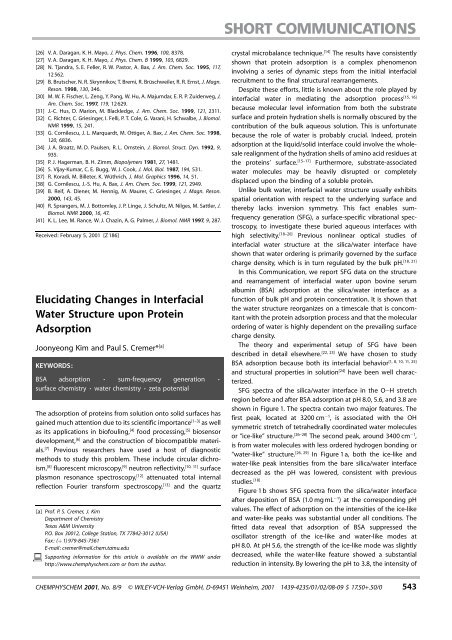
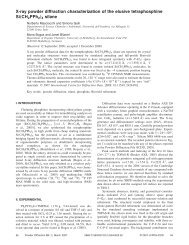
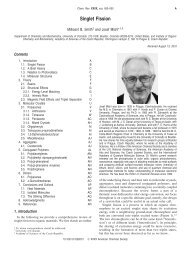
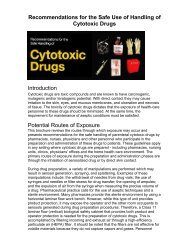
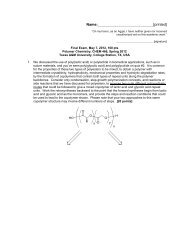

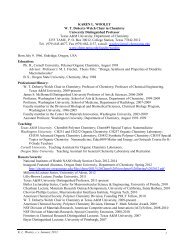
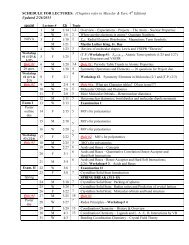
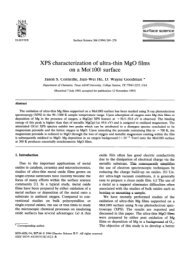
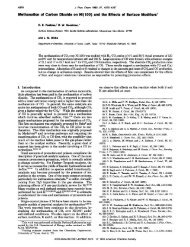
![Radical salts of TTF derivatives with the metal–metal bonded [Re2Cl8]](https://img.yumpu.com/10115211/1/190x253/radical-salts-of-ttf-derivatives-with-the-metal-metal-bonded-re2cl8.jpg?quality=85)


